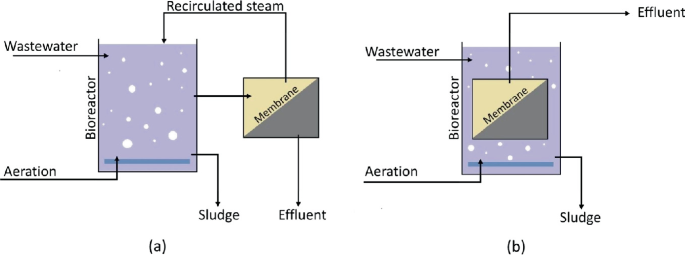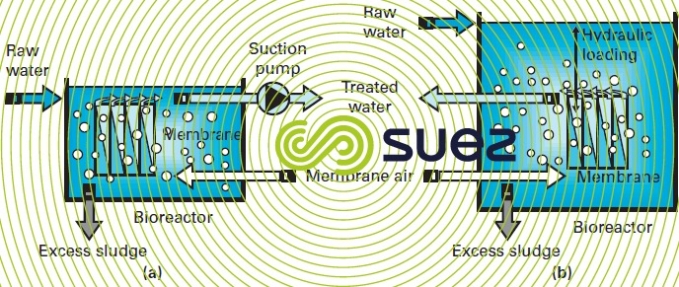Membrane Bioreactor as a Sustainable Solution for High-Volume Wastewater Treatment
Membrane Bioreactor as a Sustainable Solution for High-Volume Wastewater Treatment
Blog Article
Comprehending Membrane Bioreactors: The Future of Wastewater Therapy
Membrane bioreactors (MBRs) represent a significant development in the area of wastewater therapy, integrating biological procedures with advanced membrane filtering to boost effluent quality. As worldwide water deficiency and stringent regulative frameworks end up being increasingly pressing problems, MBR modern technology offers an effective reaction with its capacity to minimize footprint and enhance source recuperation.
What Are Membrane Bioreactors?

The core components of MBR systems include a bioreactor where microbial activity happens and a membrane system that filters the blended liquor. This double performance allows the simultaneous deterioration of raw material and solid-liquid separation in a single step. MBRs can operate in both submerged and external configurations, with immersed systems being more usual as a result of their small style and operational efficiency.
The adoption of MBR technology has actually obtained grip in different applications, ranging from community wastewater treatment to industrial effluent management. MBRs are specifically useful in circumstances where area is restricted or strict effluent top quality requirements should be met. By maintaining a high focus of bacteria within the bioreactor, MBRs improve the degradation of natural contaminants, thus yielding greater treatment efficiencies contrasted to conventional methods.
Secret Benefits of MBR Innovation
The integration of organic treatment with membrane layer filtering in MBR systems supplies many advantages that establish it aside from typical wastewater treatment approaches. One of the main advantages is the improved effluent top quality. MBRs efficiently get rid of suspended virus and solids, attaining higher levels of filtration that fulfill rigorous discharge criteria and promote water reuse applications.

One more substantial advantage is the minimized sludge production. MBR systems generate much less excess sludge, bring about lower disposal costs and a reduction in ecological influence. The closed nature of the membrane system reduces the threat of smell emissions and enhances general procedure control.
Lastly, MBRs are adaptable and flexible, making them appropriate for numerous wastewater kinds, consisting of commercial and municipal sources. The ability to integrate with sophisticated treatment innovations better boosts their performance, making MBRs an appealing service for the future of wastewater management.
Obstacles and Limitations of MBRs
While MBR technology provides various advantages, it also faces several challenges and limitations that can impact its widespread fostering. One substantial obstacle is the high resources and functional expenses connected with MBR systems. The initial investment for membrane layer products and the needed framework can be significant, making it much less easily accessible for smaller towns or industries.
Furthermore, membrane fouling continues to be a crucial issue that can lessen system efficiency and boost maintenance needs. Fouling happens when solids, raw material, or bacteria build up on the membrane layer surface area, resulting in decreased leaks in the structure and needing frequent cleansing or replacement.
Another constraint includes the complexity of the modern technology. MBR systems need experienced employees for procedure and maintenance, which can be an obstacle in regions with restricted technical proficiency. The disposal of invested membrane layers offers environmental problems, as the materials are usually not naturally degradable and can add to waste monitoring difficulties.
Last But Not Least, while MBRs can efficiently deal with a wide variety of wastewater, they might not be appropriate for all applications, specifically those with high concentrations of fats, oils, and oils, demanding further research study and innovation to attend to these constraints.
Applications of Membrane Layer Bioreactors
In various industries, membrane layer bioreactors (MBRs) have actually become a flexible option for wastewater therapy (Membrane Bioreactor). Their applications span local, commercial, and farming settings, showcasing their versatility and efficiency in varied settings. In local wastewater therapy plants, MBRs considerably improve effluent high quality, permitting water reuse and reducing the environmental impact of discharged wastewater
Industrially, MBRs are utilized in food and beverage handling, fabric production, and pharmaceutical manufacturing, where they properly deal with high-strength waste streams. Their capability to manage rising and fall lots and differing impurity focus makes them specifically beneficial in these sectors. Additionally, MBRs facilitate the elimination of virus, put on hold solids, and organic matter, adding to compliance with rigid discharge laws.
In agriculture, MBRs are significantly used for dealing with farming runoff and livestock wastewater, making it possible for the healing of nutrients for fertilizer production. They also help in the therapy of greywater for irrigation, promoting lasting water monitoring methods.
The adaptability of MBRs is additional useful link evidenced by their assimilation with various other innovations, such as anaerobic digestion and advanced oxidation procedures, boosting general performance and source healing in wastewater treatment systems.
The Future of Wastewater Therapy
Improvements in modern technology and an expanding emphasis on sustainability are forming the future of wastewater treatment. Membrane bioreactors (MBRs) exhibit this change by integrating biological treatment processes with membrane layer filtration, causing high-grade effluent appropriate for reuse. The trend in the direction of circular economies is motivating facilities to take on MBRs for their capability to recuperate resources, such as water and nutrients, from wastewater.
Technologies in membrane products and configuration are boosting the effectiveness and long life of MBR systems, decreasing functional costs and power consumption. Smart innovation integration, consisting of real-time surveillance and automated control systems, is additional maximizing performance and making it possible for predictive maintenance, hence reducing downtime.
In addition, social assumptions and regulatory pressures are pressing sectors and towns to embrace even more sustainable methods. Membrane Bioreactor. The change in the direction of decentralized wastewater treatment services is obtaining traction, permitting local therapy that reduces transportation expenses and power use
Conclusion
Membrane bioreactors (MBRs) stand for a transformative strategy to wastewater treatment, integrating biological processes with sophisticated membrane layer modern technology. The advantages of MBRs, including improved effluent high quality, lowered spatial needs, and reduced sludge production, position them as a sensible option in the middle of expanding urbanization and more stringent ecological regulations. Despite existing challenges, the Related Site continued development in membrane materials and operational techniques promises to reinforce the effectiveness and fostering of MBRs, guaranteeing their crucial duty in the future of lasting wastewater monitoring.
Membrane layer bioreactors (MBRs) represent a notable development in the field of wastewater treatment, integrating organic procedures with sophisticated membrane filtration to enhance effluent top quality.Membrane layer bioreactors (MBRs) incorporate organic treatment processes with membrane purification to properly deal with wastewater.The combination of biological treatment with membrane layer filtering in MBR systems provides various advantages that establish it apart from standard wastewater treatment methods. Membrane layer bioreactors (MBRs) exhibit this shift by incorporating organic treatment processes with membrane layer purification, resulting in top notch effluent have a peek here appropriate for reuse.Membrane bioreactors (MBRs) represent a transformative strategy to wastewater therapy, integrating organic processes with advanced membrane layer innovation.
Report this page